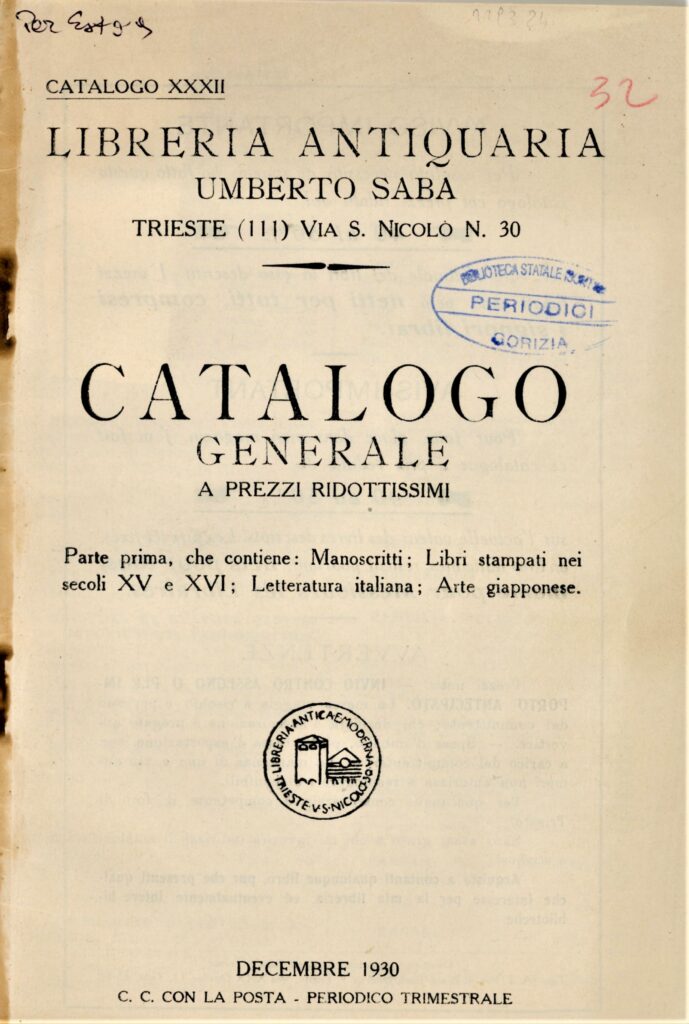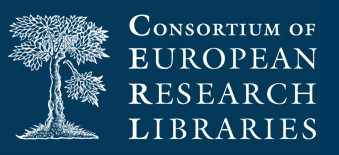Umberto inherited from his aunt Regina Coen, a sum of money with which, in 1919, he purchased, in partnership with Giorgio Fano, the bookshop at via San Nicolò 30. Virgilio Giotti, met by Saba in Florence, designed the logo, the Cathedral of San Giusto inscribed within a circle.
In 1924 the business was registered under the new name of the Libreria antiquaria «Umberto Saba» (the “Umberto Saba” antiquarian bookshop). The poet turned the desk in his shop into his “atelier”, where he assembled, composing and recomposing, his own verses and, at the same time, the bibliographer’s workshop. “I didn’t understand ancient books”. “As soon as I knew that incunabula existed and that Aldo Manuzio had been a great printer of the 16th century. …I took my first steps under the guidance – or rather, under the star – of Tammaro de Marinis” he reported in 1948 in Storia di una libreria (11). With wise intelligence he built a network of relationships with the main Italian antiquarians to the point of confessing to Aldo Fortuna, on 2nd June 1920, that he suffered palpitations for the beautiful volumes he was expecting from Florence: “…I am now almost ready to become a bibliophile myself”.
This comes from the “dark cave of the poet”, La libreria de’Volpi, and the Stamperia cominiana (Padua 1756), which illustrated the activity of Giuseppe Comino, the printer of the Volpi di Bassano, a publisher of classics that are highly sought after by collectors. (12)
(Trieste : Arti grafiche L. Smolars & nipote)
n. 8 (mag.1925) n. 22 (dic. 1928); n. 32 (dic. 1930) ; 17 cm
Il poeta comincia a pubblicare sin dal 1923 il Catalogo della Libreria antiquaria “Umberto Saba”, un bimestrale, in seguito dalla periodicità variabile.
Provenienza Gorizia, Biblioteca Statale Isontina
Umberto Saba based his expertise in the field of books printed in the 15th century by consulting the catalogues of Leo Olschki, a bookseller and founder of the publishing house, one of the masters in the description and marketing of ancient books. Saba owned and consulted Le Livre illustré au 15. siècle avec 344 figures sur 220 planches (Florence 1926) (13), but also owned the bibliographical repertoire of incunabula by Ludwig Hain (Berlin, Altmann 1925). The poet demonstrated his bibliographical expertise by publishing the Catalogues of the “Umberto Saba antiquarian bookshop” from 1923 onwards. Catalogues no. 8 (May 2025) and no. 22 (December 1928) are on display, offering examples of 16th century editions of Petrarch. In catalogue no. 32 (December 1930) the bookshop offered for sale a copy of Il Secretum (Zopino 1520) with the monogram with which an engraver signs for the first time, Z. A. (Zoan Andrea). (16)
The Antiquarian Bookshop was recognised in 2012 as an artist’s studio of particular interest for its historical value, and is under the protection of the Ministry of Culture. Saba transcribed cryptograms of numbers and letters in pencil on the back covers and flyleaves of the 834 publications that remained in the via San Nicolò bookshop. The catalogue of books, described in 2016, now available for consultation in the OPAC Biblioest, testifies to the possession of bibliographies and catalogues of libraries and antiquarian bookshops from half of Europe. In addition to the publications on the collections of the ancient Ulrico Hoepli library and the catalogue of the printer Bodoni (the Rudolf Geering bookshop, Basel 1920), there are some bibliographies that are indispensable in a conservation library including the Bibliografia leopardiana by Giuseppe Mazzatinti (Olschki 1931), the Annali delle edizioni ariostee by Giuseppe Agnelli and Giuseppe Ravegnani (Zanichelli 1933); the Annali degli stampatori Elsevier by Charles Pieters (chez C. Annoot-Braeckman, Ghent 1851). Other testimonies of Saba’s commitment to his profession as a bibliophile are his copy of The Manual of Classical Bibliography by Joseph William Moss (London Bohn 1837) and the Taschenbibliographien für Büchersammler (the “Pocket bibliography for the book collector”), edited by Max Sander (Stuttgart, Hofmann 1925-1926). And these are only the books that survive today on the shelves of the Artist’s Studio in via San Nicolò, because they did not find buyers after the poet’s death. In the Fondo Saba della Libreria, described in the virtual catalogue of the Civic Library “A. Hortis”, but belonging to the “Umberto Saba” antiquarian bookshop, appear extremely significant books of the culture from the 19th and 20th centuries such as The civilization of the Renaissance in Italy by Jakob Burckhardt (9th ed. Leipzig, Seemann, 1904), in the original language, of which the copy of the Civic Library “A. Hortis” is exhibited (15).




